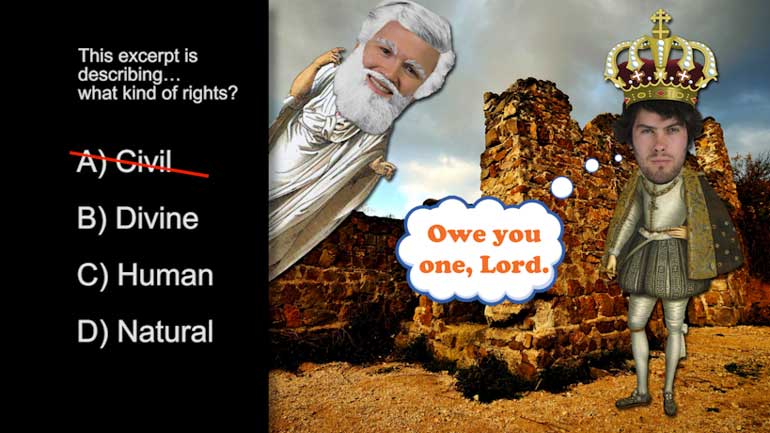ShmoopTube
Where Monty Python meets your 10th grade teacher.
Search Thousands of Shmoop Videos
Famous Biographies Videos 22 videos
Don't get your hopes up,this guy isn't here to pump you up with his brother, Hans. Franz was more into pumping you down, with dark and scary storie...
Unlike most writers we hear about from the 1800s, Twain was actually pretty famous and respected in his day...although not for his real name, of co...
Orwell had a lot of pretty dismal views about what the world could be like in the future Good thing they didn't come true...or did they? Nah, we do...
History Trivia: Fannie Lou Hamer: First African American Woman Delegate at DNC 23 Views
Share It!
Description:
Wonder Woman... Black Widow... Fannie Lou Hamer... Yeah, it's kind of got that superhero ring to it, doesn't it?
Transcript
- 00:04
Using the Discriminant, a la Shmoop.
- 00:07
It's never okay to discriminate… [Kids fighting on a bus]
- 00:09
…but you can definitely use the discriminant to help answer some of life's most difficult [Magic discriminant ball]
- 00:14
questions.
- 00:15
In the quadratic formula b2 – 4ac is the discriminant. [Teacher writing on a whiteboard]
Full Transcript
- 00:20
The discriminant determines the nature and number of solutions of a quadratic equation.
- 00:25
If b2 – 4ac is positive and greater than zero, there will be two distinct, real solutions. [2 real solutions appear from the magic discriminant ball]
- 00:34
If b2 – 4ac is zero, there will be one distinct, real solution. [1 real solution appears from the magic discriminant ball]
- 00:39
But, if b2 – 4ac is negative and less than zero, there are no real solutions.
- 00:46
Let's get quadratic for a couple of examples.
- 00:49
Our first example is x-squared plus three-x plus five equals zero. [The equation is written out]
- 00:54
Plugging these bad boys into the discriminant, b squared minus 4ac, we get three-squared
- 01:00
minus four-times-one-times-five.
- 01:04
This simplifies to nine minus twenty, which is negative eleven.
- 01:08
This is less than zero…so there are no real solutions. [Guy holding his arms up]
- 01:14
What does “no real solutions” mean? [Students in class]
- 01:16
If we take a look at the graph, the parabola does not touch the x-axis at any x-value. [Finger going along the x-axis]
- 01:22
So it's not real, it doesn't exist.
- 01:25
For our second example, we have the equation...
- 01:27
x-squared minus six-x minus ten equals zero. [The equation is written out]
- 01:31
Plugging this into the discriminant it looks like...
- 01:34
six-squared minus four times negative-ten times one.
- 01:39
This is thirty-six plus forty, which is seventy-six.
- 01:43
Seventy-six is greater than zero.
- 01:46
So there are two distinct, real solutions to this problem. [Guy looks happy]
- 01:51
By looking at the graph, we can see that there are two real solutions because the parabola [Arrows point to the solutions on the graph]
- 01:56
touches the x-axis at two distinct x-values.
- 02:01
Okay, so the Magic Discriminant Ball might not be able to help you with some of life's [Guy asking the ball a random question]
- 02:05
biggest questions… [The magic discriminant ball looks angry]
- 02:07
… but using the discriminant can help you ace your next math test. [Guy looks happy as he gets an A+ on his test]
Related Videos
GED Social Studies 1.1 Civics and Government
When you're about to marry the love of your life, not many things could stop you. However, finding out that your future hubby is keeping his crazy...
Here at Shmoop, we work for kids, not just the bottom line. Founded by David Siminoff and his wife Ellen Siminoff, Shmoop was originally conceived...
ACT Math: Elementary Algebra Drill 4, Problem 5. What is the solution to the problem shown?
























